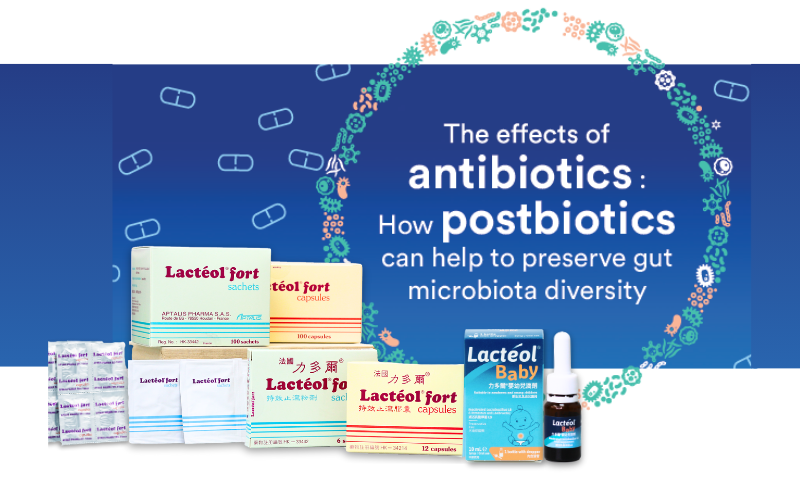Subtotal: $350.00
Health Tips
When prescribing an antibiotic, pair it with the postbiotic pioneer Lactéol® fort
DIARRHEA: THE MOST COMMON SHORT-TERM SIDE EFFECT OF ANTIBIOTICS , A GREATER IMPACT IN INFANTS AND CHILDREN
Up to 49% of people taking antibiotics will develop antibiotic-associated diarrhea (AAD).3 In 10-20% of cases, AAD can increase the risk of Clostridioides difficile infection which can cause chronic recurrent infections and even potentially lethal pseudomembranous colitis.1,4
The microbiota alterations can also result in an increased susceptibility to infections from various opportunistic microorganisms, compromised immune homeostasis, and deregulated metabolism.1
Following a course of antibiotics, the intestinal microbiota can take years to recover.1 Unfortunately, this age group experiences bacterial infections more often than adults leading to frequent antibiotic use.5,6
The perinatal period is essential for microbiota establishment and immune system development. Therefore, the impact of the microbiota alterations caused by antibiotics is of particular concern in infants and children who still have a poor microbiota and immature immune system.7,8
Up to 80% of children treated with antibiotics experience antibiotic-associated diarrhea.9 Children treated with antibiotics are known to have less diverse and less stable intestinal microbiota.7 It has even been suggested that these changes could be definitive.8,10

It has been shown that exposure to antibiotics during the neonatal period can impair growth whereas exposure later in childhood can increase a child’s body mass index.11 Links have also been identified between using antibiotics during the perinatal period and early childhood and developing autoimmune, allergic or metabolic diseases during childhood.1,2
Lactéol® fort Inactivated Lactobacillus LB and fermented culture medium. A POSTBIOTIC CAN HELP!
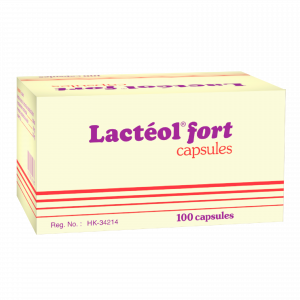
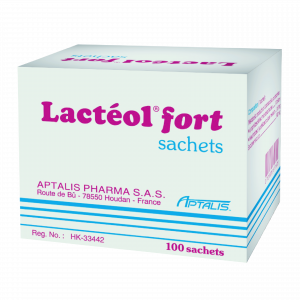
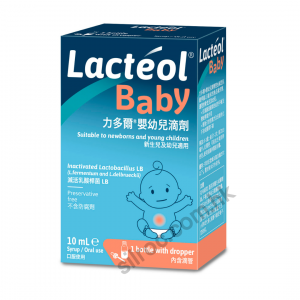
Lactéol® fort is indicated in:16,17 symptomatic treatment of diarrhea, which also helps to prevent antibiotic-associated diarrhea.
- Lactéol® fort is a postbiotic composed of stabilized, heat-treated LB and metabolite-enriched culture medium.
- Lactéol® fort acts directly in the gut, stimulating the growth of the naturally present beneficial bacteria thus helping to restore and rebalance the intestinal microbiota.13,14
- Since the bacteria contained in Lactéol® fort are inanimate, it can be prescribed at the same time with antibiotics to help restore the intestinal microbiota and preventantibiotic-associated diarrhea.15
The effects of antibiotics : How postbiotics can help to preserve gut microbiota diversity

Antibiotics are among the most widely prescribed medications around the world. They are highly effective at treating bacterial infections. However, they do not just kill the disease-causing bacteria, they will also kill beneficial bacteria within the microbiota. Broad-spectrum antibiotics kill a wide range of bacteria and can therefore significantly and rapidly reduce microbiota richness and diversity resulting in microbiota alterations, called dysbiosis1,2. This can have serious side effects.
Find out more about how postbiotics preserve gut microbiota diversity
1.Francino MP. Antibiotics and the Human Gut Microbiome: Dysbioses and Accumulation of Resistances. Front Microbiol. 2015;6:1543.
2.Lange K, Buerger M, Stallmach A,Bruns T.Effects of Antibiotics on Gut Microbiota. Dig Dis. 2016;34(3):260-268.
3.Dietrich CG, Kottmann T, Alavi M. Commercially avaliable probiotic drinks containing Lactobacillus casei DN-114001 reduce antibiotic-associated diarrhea. World J Gastroenterol. 2014;20(42):15837-15844.
4. Theriot CM, et al. Interactions between the gastrointestinal microbiome and Clostidium difficile. Annu Rev Microbiol. 2015;69:445-461.
5. Garedow AW, Tesfaye GT. Evaluation of Antibiotics Use and its Predictors at Pediatrics Ward of Jimma Medical Center: Hospital Based Prospective Cross-sectional Study. Infect Drug Resist. 2022;15:5365-5375.
6. Husni A, Abdoerrachman H, Akib A. Antibiotic profile in pediatric wards, Department of Child Health, Cipto Mangunkusumo Hospital. Paediatrica Indonesiana. 2016;44:46.
7. Yassour M, Vatanen T, Siljander H, et al. Natural history of the infant gut microbiome and impact of antibiotic treatment on bacterial strain diversity and stability. Sci Transl Med. 2016;8(343):343-381.
8. Reyman M, van Houten MA, Watson RL, et al. Effects of ear- ly-life antibiotics on the developing infant gut microbiome and resistome: a randomized trial. Nat Commun. 2022;13(1):893.
9. McFarland LV, Ozen M, et al. Comparison of pediatric and adult antibiotic-associated diarrhea and Clostridium difficile infections. World J Gastroenterol. 2016;22(11):3078-3104 10. Oldenburg CE, Sié A, Coulibaly B, et al. Effect of Commonly.
13. Warda AK, Clooney AG, Ryan F, et al. A postbiotic consisting of heat-treated lactobacilli has a bifidogenic effect in pure culture and in human fermented faecal communities. Appl Environ Microbiol. 2021;87(8).
14. Liévin-Le Moal V. A gastrointestinal anti-infectious biotherapeutic agent: the heat-treated Lactobacillus LB. Therap Adv Gastroenterol. 2016;9(1):57-75.
15. Yap SKJ, Gwee KA, Chen Z, Tai BC, Wong ML. Lacteol Fort Treatment Reduces Antibiotic Associated Diarrhea. The Singapore Family Physician 2010;36:46-49.
16. LactéolR capsules. Summary of Product Characteristics. 17. LactéolR sachets. Summary of Product Characteristics.


 中文 (中国)
中文 (中国) 中文 (香港)
中文 (香港)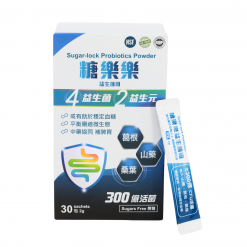 Sugar-lock Probiotics Powder
Sugar-lock Probiotics Powder 